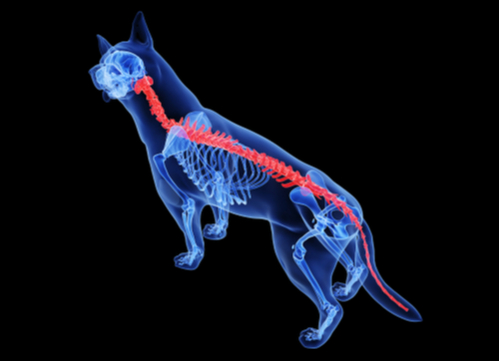Causes, Prevention, Signs & Treatment – Top Dog Tips
Your dog’s back is incredibly important to them. Animals that walk on four legs rely on their hindquarters for certain things and their front quarters for other things. The dog’s back is what brings both ends together so that they can function fully. Dog back injury, therefore, can affect so many of a dog’s capabilities, from moving about to getting up, lying back down again and more. In this article we will take a look at some of the causes and signs of a dog back injury, along with prevention tips and treatment ideas.
In this article we will discuss:
- 5 common back problems in dogs
- Dog back injury: Signs to look out for
- How to prevent back problems for your dog
- Treatment for dog back injury
5 Common Back Injuries In Dogs
Osteoarthritis
Osteoarthritis is a condition more commonly associated with older dogs, it is caused by the long-term degeneration of joint cartilage, which leads to chronic joint inflammation.
Subluxations
Subluxations is a condition that can interrupt nerve function due to misalignment of the dog’s vertebrae. This is caused by poor posture over time, and in some cases trauma. Dog owners may observe their dog becoming clumsy, and this is because the issues with the nervous system can interfere with the communication between the brain and other parts of the body.

Intervertebral Disc Disease
Intervertebral Disc Disease is a back condition also known as a slipped disc. It is very common in dachshunds whose short legs are not designed to provide proper support to their long backs. Beagles and Basset Hounds are also genetically susceptible to Intervertebral Disc Disease. The condition happens when the jelly-like discs between the vertebrae either bulge or burst, placing pressure on the nerves in and around the spinal cord. It can cause significant pain to the neck and back, and also affect the hind area causing weakness or even paralysis.
Lumbosacral Syndrome
Lumbosacral Syndrome can affect large breeds of dog, like the German shepherd. The nerves in the lower back area of the spine become compressed, which causes pain and weakness or paralysis in the hind area. It can lead to incontinence, abnormal reflexes, and tail abnormalities in the way that the tail is carried.
Soft Tissue Trauma
You might recognize Soft Tissue Trauma in the form of sprains, strains and pulled muscles. While not serious ailments, these can still be very painful and restrict movement for a little while.
Dog Back Injury: Signs To Look Out For
It can be frustrating and worrying when you know that your dog just doesn’t seem right, but it isn’t clear what the problem is. If you are worried that your dog could be experiencing some kind of back problem you should take them to see a veterinarian who can do a thorough examination.
In the meantime, here are some signs to look out for in your dog:
- Reluctance to go up stairs or on his daily walk
- Walking gingerly or seeming wobbly or drunk, especially the hind limbs
- General lethargy and reluctance to move or play as usual
- Not as enthusiastic about dinner
- A decrease in appetite that is not associated with vomiting or diarrhea
- There’s a look in your dog’s eyes and you suspect he’s not feeling his best
- A change in attitude, and your dog is not as “up for it” as he usually is
- Aggression that is out of character for your dog
- Snappy or grumpy when picked up or petted
- Reluctant to lift the head fully, and may assume a hunched posture
- Tense abdomen, the muscles could be trying to support a sore back
- Tremors or shivering when it isn’t cold are often a sign of pain
How To Prevent Back Problems For Your Dog
One of the best things you can do to avoid future back problems is to control your dog’s weight. This means making sure that they are eating the right amount of food for their size and weight, and that they are getting adequate daily exercise.
Obesity is one of the main things that lead to back issues. The extra weight adds unnecessary pressure to problem areas, exacerbating symptoms and causing new ones.
It doesn’t take very much for your dog to be considered overeating or overweight, so it is very important to keep an eye on their health. When you look after your dog’s weight you are also looking after their spine, and this is one of the most important things you can do to prevent back problems.
Another way that you can avoid back problems may not be something you want to hear because your dog enjoys it so much, but playing tug of war with your dog isn’t a good idea. This is because the game places a lot of strain on your dog’s back, and the enthusiastic twisting and turning involved can cause spine injuries.
Also, be careful when you lift your dog up. You must support your dogs back when you lift them by placing one of your hands under the abdomen and one under the chest. This way you can lift the dog evenly, keeping the spine straight.
And lastly, jumping, although one of the things that all dogs love to do, should be discouraged. It is actually one of the worst actions for a dog’s spine. So if your dog likes to jump up to say hello, maybe start coming down to their level instead in order to preserve their back.
Treatment For Dog Back Injury
The treatment for your dog’s back injury will depend on the injury itself. But here are some pain remedies that can help a dog with a sore back.

Traditional pain medications from your veterinarian – Medication for pain relief like this should be approached with caution as it can sometimes do more harm than good, causing your dog to worsen their injury because they can’t feel the pain, which is there precisely to stop this from happening.
Physical Therapy – This can help to relieve back pain by strengthening weak parts of the body and stretching out areas that have tightness.
Hydrotherapy – Using the buoyancy of water in Hydrotherapy to support the dog, helps to reduce pressure on the muscles and joints while they regain their mobility and rebuild strength. Typically, with experience, dogs do well in water.
Laser Therapy – This technique stimulates the body’s natural ability to heal.
Ultrasound – This is a treatment that uses sound waves to heal, increasing blood flow, reducing swelling and inflammation, and relieving pain.
Acupuncture – In Chinese medicine pain is cause by stagnation in the body. Acupuncture improves the flow of energy, and therefore helps to reduce pain.
Summary
Back pain can be uncomfortable, painful, and disabling for your dog. The worst thing is that your dog can’t tell you when something is wrong, and when you know something is irritating them, they can’t tell you what it is. Hopefully now you will have a better idea of what signs to look out for, and a clear understanding of what the causes and types of back injury are, along with potential treatment options to help your dog.





